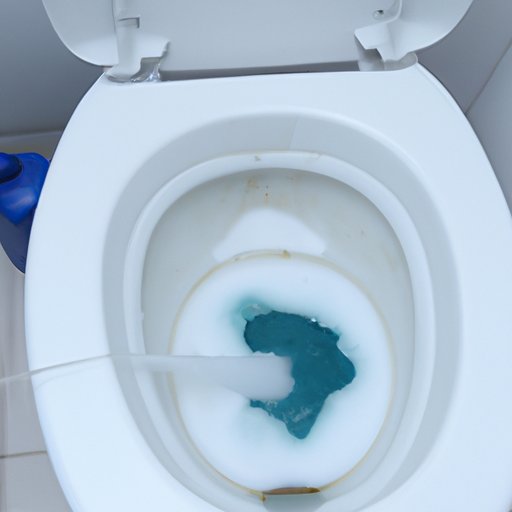
I. Introduction
Keeping a clean and well-maintained toilet tank is essential for good hygiene, preventing blockages, and avoiding leaks. However, cleaning a toilet tank can be a daunting task for many people. In this article, we will provide you with a step-by-step guide on how to clean and maintain your toilet tank effectively and easily.
II. Step-by-Step Guide
Before starting the cleaning process, you will need to gather a few tools and materials. You will need gloves, a bucket, a toilet brush, a scrub brush, and a cleaning solution. First, turn off the water supply to the tank by locating the valve located on the toilet’s wall and then flush the toilet to empty the tank. Next, remove any remaining water using a sponge or cloth.
Begin cleaning the inside of the tank with a cleaning solution of your choice and a scrub brush. Pay close attention to the corners, hard-to-reach areas, and any stains. Use the toilet brush to scrub the inside of the bowl while the tank is open. Once everything is cleaned, rinse the tank thoroughly with water and flush it multiple times. Finally, turn on the water supply again and check for any leaks.
It is essential to follow safety measures while cleaning a toilet tank. Always wear gloves to avoid contact with bacteria and germs. Additionally, avoid using harsh chemicals and follow the instructions on the cleaning solution bottle carefully.
III. DIY Cleaning Solution
DIY cleaning solutions are eco-friendly and effective alternatives to commercial cleaning products, which are often harsh and chemical-laden. You can use natural ingredients like baking soda, vinegar, and lemon juice to create a DIY cleaning solution for your toilet tank.
To create a cleaning solution using vinegar, mix equal parts of vinegar and water in a bucket. You can also add baking soda to the mix to make it more effective. Apply the solution to the inside of the tank and let it sit for at least 30 minutes. Scrub it clean with a brush and rinse it with water.
To create a cleaning solution using lemon juice, mix lemon juice and baking soda to make a paste. Apply the paste to the tank and let it sit for at least 30 minutes. Scrub it clean and rinse thoroughly with water.
Using eco-friendly cleaning solutions significantly reduces your exposure to harmful chemicals and helps protect the environment.
IV. Maintenance Tips
Preventing blockages and overflow in your toilet tank is much easier than dealing with the aftermath of a blockage. Follow these tips to keep your toilet tank clean and functioning properly:
- Do not flush anything other than toilet paper and bodily waste down the toilet.
- Regularly inspect the flapper valve and replace it if necessary.
- Use a plunger to release minor blockages before they worsen.
If you detect any signs of leaks or damage, it is crucial to address the issue immediately. Leaks can result in expensive repairs and can also damage the environment. To detect leaks, add a few drops of food coloring to the tank and check if it appears in the bowl.
V. Common Mistakes to Avoid
The most common mistake people make while cleaning their toilet tanks is using chlorine bleach. While bleach is effective, it can cause damage to rubber gaskets and seals, and it is also harmful to the environment.
Another mistake people make is not using gloves while cleaning. Coming into contact with bacteria and germs can lead to health issues, and it is also gross. It is essential to invest in a pair of gloves dedicated to cleaning your toilet.
Finally, using a metal scrub brush could leave scratches on the porcelain surface of the toilet bowl. Instead, it is best to use a soft nylon brush.
VI. Comparison of Different Cleaning Methods
There are various methods for cleaning toilet tanks, and each has its pros and cons.
- The vinegar and baking soda method is a cost-effective and eco-friendly option, but it may take longer to clean if the stains are stubborn.
- The chlorine bleach method is highly effective but can damage the rubber seals and gaskets in the toilet tank, and it is also harmful to the environment.
- The commercial cleaning products method is highly effective, but they are chemical-laden and can cause damage to the environment.
The best method to use depends on your preference, and the circumstances in your home.
VII. Conclusion
Cleaning your toilet tank is essential for your health and hygiene. Follow our step-by-step guide and the useful tips we have provided, and your toilet tank will remain clean and functional for a long time. Remember to always use safety precautions and avoid making common mistakes. Take pride in maintaining a clean toilet, and enjoy the many benefits that come with it.




